Management Accounting: Reporting, Techniques, and Internal Control
VerifiedAdded on 2021/02/20
|19
|4159
|109
Report
AI Summary
This report provides a comprehensive overview of management accounting, detailing its role in business operations and financial performance analysis. It explores the management accounting system, various types such as cost accounting, job costing, and inventory management, and their essential requirements. The report highlights different methods of management accounting reporting, including inventory, cash, cost, performance, and budget reports, along with the techniques of marginal and absorption costing. It includes detailed financial statements prepared using both marginal and absorption costing methods, along with an interpretation of the results. The report also analyzes effective planning tools used for budgetary control systems, outlining their benefits and drawbacks, and emphasizes the role of management accounting in improving a company's ability to respond to financial challenges.
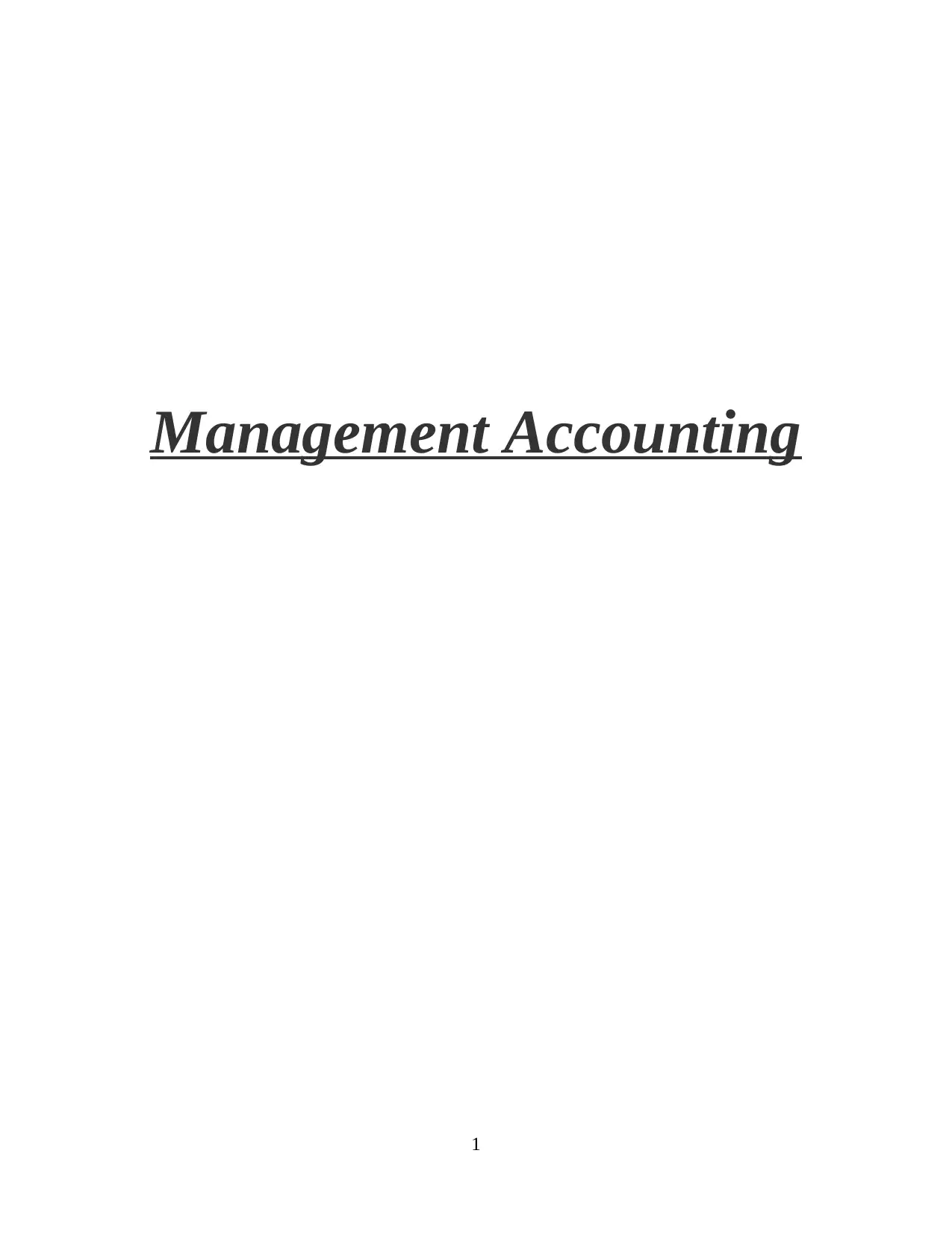
Management Accounting
1
1
Paraphrase This Document
Need a fresh take? Get an instant paraphrase of this document with our AI Paraphraser
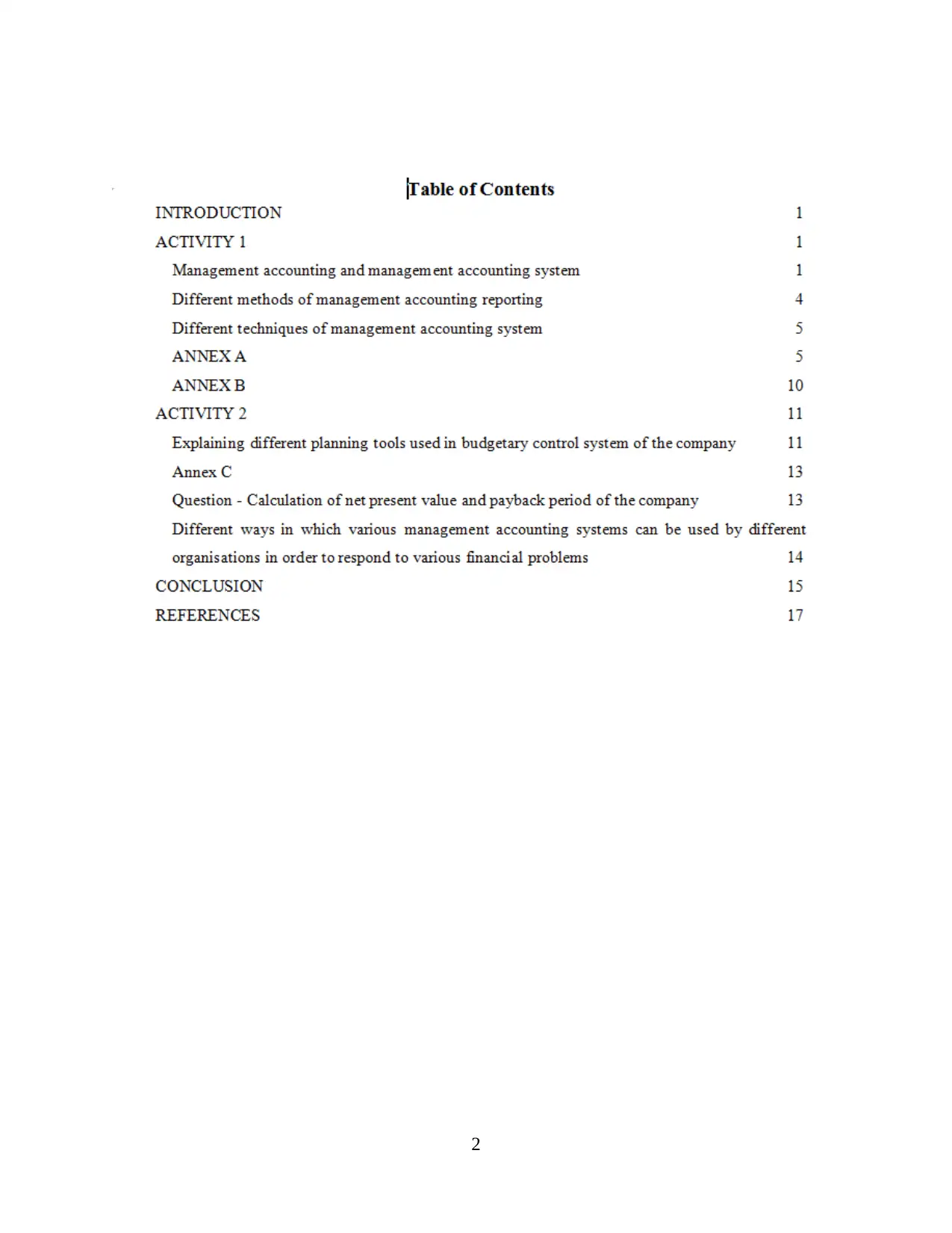
2
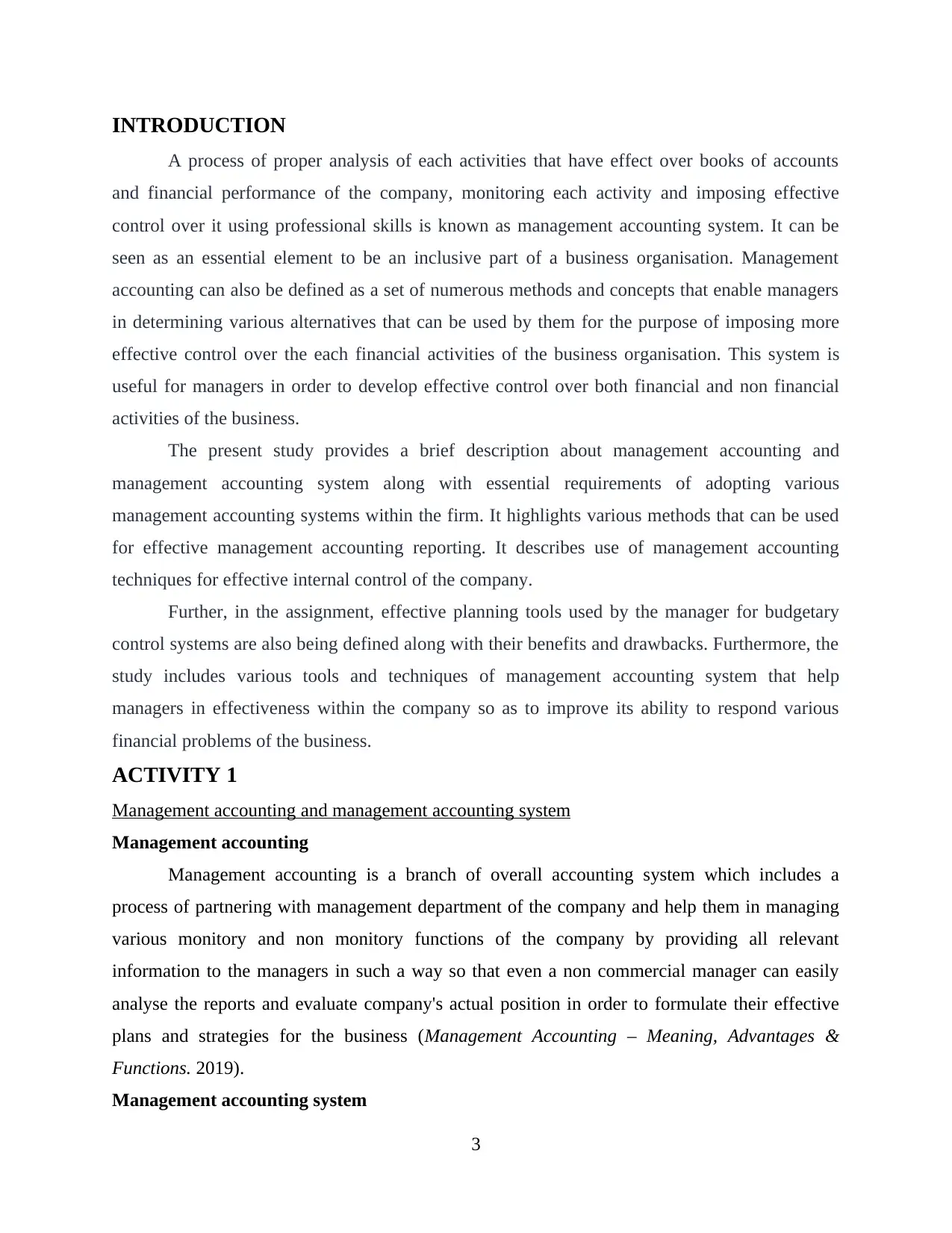
INTRODUCTION
A process of proper analysis of each activities that have effect over books of accounts
and financial performance of the company, monitoring each activity and imposing effective
control over it using professional skills is known as management accounting system. It can be
seen as an essential element to be an inclusive part of a business organisation. Management
accounting can also be defined as a set of numerous methods and concepts that enable managers
in determining various alternatives that can be used by them for the purpose of imposing more
effective control over the each financial activities of the business organisation. This system is
useful for managers in order to develop effective control over both financial and non financial
activities of the business.
The present study provides a brief description about management accounting and
management accounting system along with essential requirements of adopting various
management accounting systems within the firm. It highlights various methods that can be used
for effective management accounting reporting. It describes use of management accounting
techniques for effective internal control of the company.
Further, in the assignment, effective planning tools used by the manager for budgetary
control systems are also being defined along with their benefits and drawbacks. Furthermore, the
study includes various tools and techniques of management accounting system that help
managers in effectiveness within the company so as to improve its ability to respond various
financial problems of the business.
ACTIVITY 1
Management accounting and management accounting system
Management accounting
Management accounting is a branch of overall accounting system which includes a
process of partnering with management department of the company and help them in managing
various monitory and non monitory functions of the company by providing all relevant
information to the managers in such a way so that even a non commercial manager can easily
analyse the reports and evaluate company's actual position in order to formulate their effective
plans and strategies for the business (Management Accounting – Meaning, Advantages &
Functions. 2019).
Management accounting system
3
A process of proper analysis of each activities that have effect over books of accounts
and financial performance of the company, monitoring each activity and imposing effective
control over it using professional skills is known as management accounting system. It can be
seen as an essential element to be an inclusive part of a business organisation. Management
accounting can also be defined as a set of numerous methods and concepts that enable managers
in determining various alternatives that can be used by them for the purpose of imposing more
effective control over the each financial activities of the business organisation. This system is
useful for managers in order to develop effective control over both financial and non financial
activities of the business.
The present study provides a brief description about management accounting and
management accounting system along with essential requirements of adopting various
management accounting systems within the firm. It highlights various methods that can be used
for effective management accounting reporting. It describes use of management accounting
techniques for effective internal control of the company.
Further, in the assignment, effective planning tools used by the manager for budgetary
control systems are also being defined along with their benefits and drawbacks. Furthermore, the
study includes various tools and techniques of management accounting system that help
managers in effectiveness within the company so as to improve its ability to respond various
financial problems of the business.
ACTIVITY 1
Management accounting and management accounting system
Management accounting
Management accounting is a branch of overall accounting system which includes a
process of partnering with management department of the company and help them in managing
various monitory and non monitory functions of the company by providing all relevant
information to the managers in such a way so that even a non commercial manager can easily
analyse the reports and evaluate company's actual position in order to formulate their effective
plans and strategies for the business (Management Accounting – Meaning, Advantages &
Functions. 2019).
Management accounting system
3
⊘ This is a preview!⊘
Do you want full access?
Subscribe today to unlock all pages.

Trusted by 1+ million students worldwide
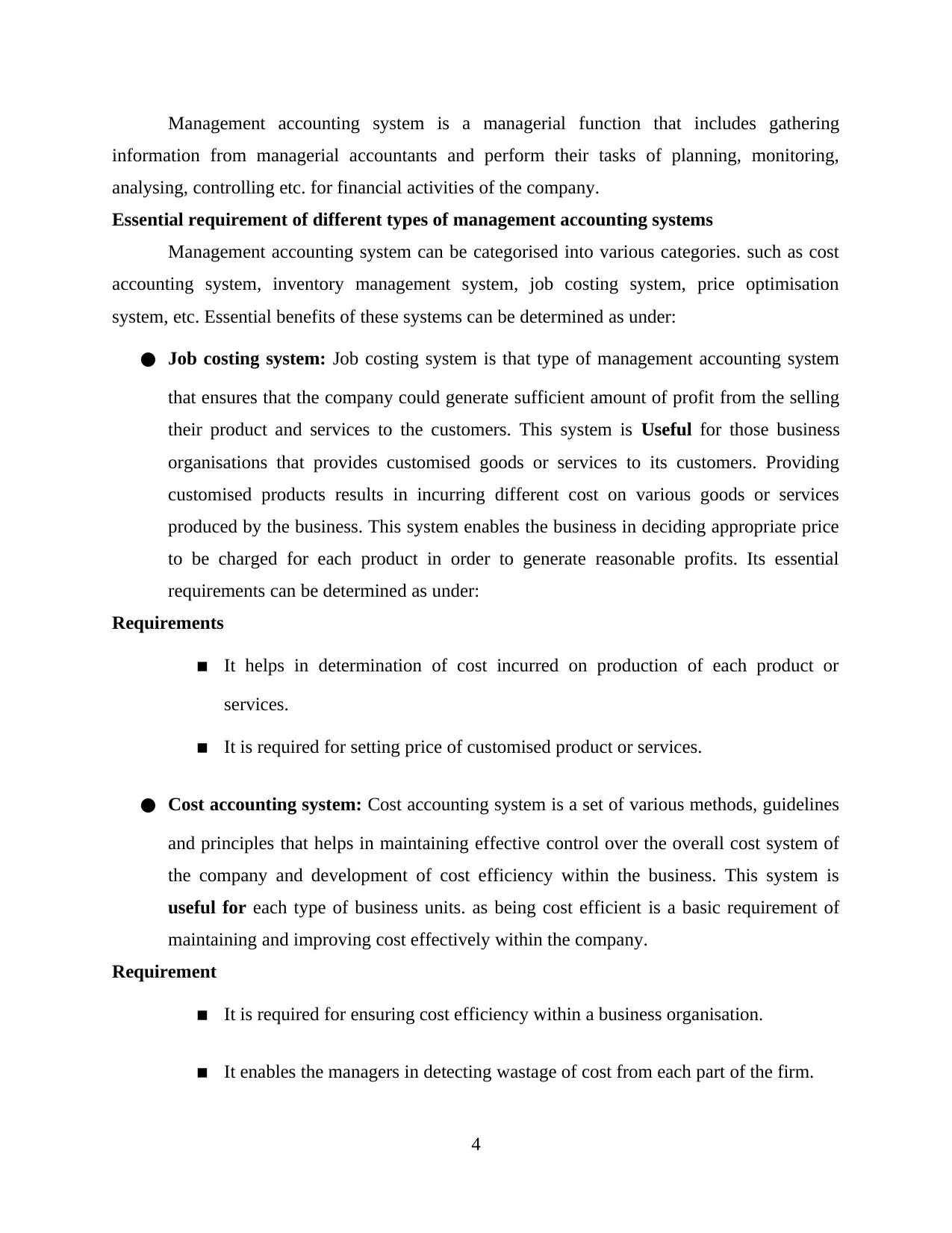
Management accounting system is a managerial function that includes gathering
information from managerial accountants and perform their tasks of planning, monitoring,
analysing, controlling etc. for financial activities of the company.
Essential requirement of different types of management accounting systems
Management accounting system can be categorised into various categories. such as cost
accounting system, inventory management system, job costing system, price optimisation
system, etc. Essential benefits of these systems can be determined as under:
● Job costing system: Job costing system is that type of management accounting system
that ensures that the company could generate sufficient amount of profit from the selling
their product and services to the customers. This system is Useful for those business
organisations that provides customised goods or services to its customers. Providing
customised products results in incurring different cost on various goods or services
produced by the business. This system enables the business in deciding appropriate price
to be charged for each product in order to generate reasonable profits. Its essential
requirements can be determined as under:
Requirements
▪ It helps in determination of cost incurred on production of each product or
services.
▪ It is required for setting price of customised product or services.
● Cost accounting system: Cost accounting system is a set of various methods, guidelines
and principles that helps in maintaining effective control over the overall cost system of
the company and development of cost efficiency within the business. This system is
useful for each type of business units. as being cost efficient is a basic requirement of
maintaining and improving cost effectively within the company.
Requirement
▪ It is required for ensuring cost efficiency within a business organisation.
▪ It enables the managers in detecting wastage of cost from each part of the firm.
4
information from managerial accountants and perform their tasks of planning, monitoring,
analysing, controlling etc. for financial activities of the company.
Essential requirement of different types of management accounting systems
Management accounting system can be categorised into various categories. such as cost
accounting system, inventory management system, job costing system, price optimisation
system, etc. Essential benefits of these systems can be determined as under:
● Job costing system: Job costing system is that type of management accounting system
that ensures that the company could generate sufficient amount of profit from the selling
their product and services to the customers. This system is Useful for those business
organisations that provides customised goods or services to its customers. Providing
customised products results in incurring different cost on various goods or services
produced by the business. This system enables the business in deciding appropriate price
to be charged for each product in order to generate reasonable profits. Its essential
requirements can be determined as under:
Requirements
▪ It helps in determination of cost incurred on production of each product or
services.
▪ It is required for setting price of customised product or services.
● Cost accounting system: Cost accounting system is a set of various methods, guidelines
and principles that helps in maintaining effective control over the overall cost system of
the company and development of cost efficiency within the business. This system is
useful for each type of business units. as being cost efficient is a basic requirement of
maintaining and improving cost effectively within the company.
Requirement
▪ It is required for ensuring cost efficiency within a business organisation.
▪ It enables the managers in detecting wastage of cost from each part of the firm.
4
Paraphrase This Document
Need a fresh take? Get an instant paraphrase of this document with our AI Paraphraser
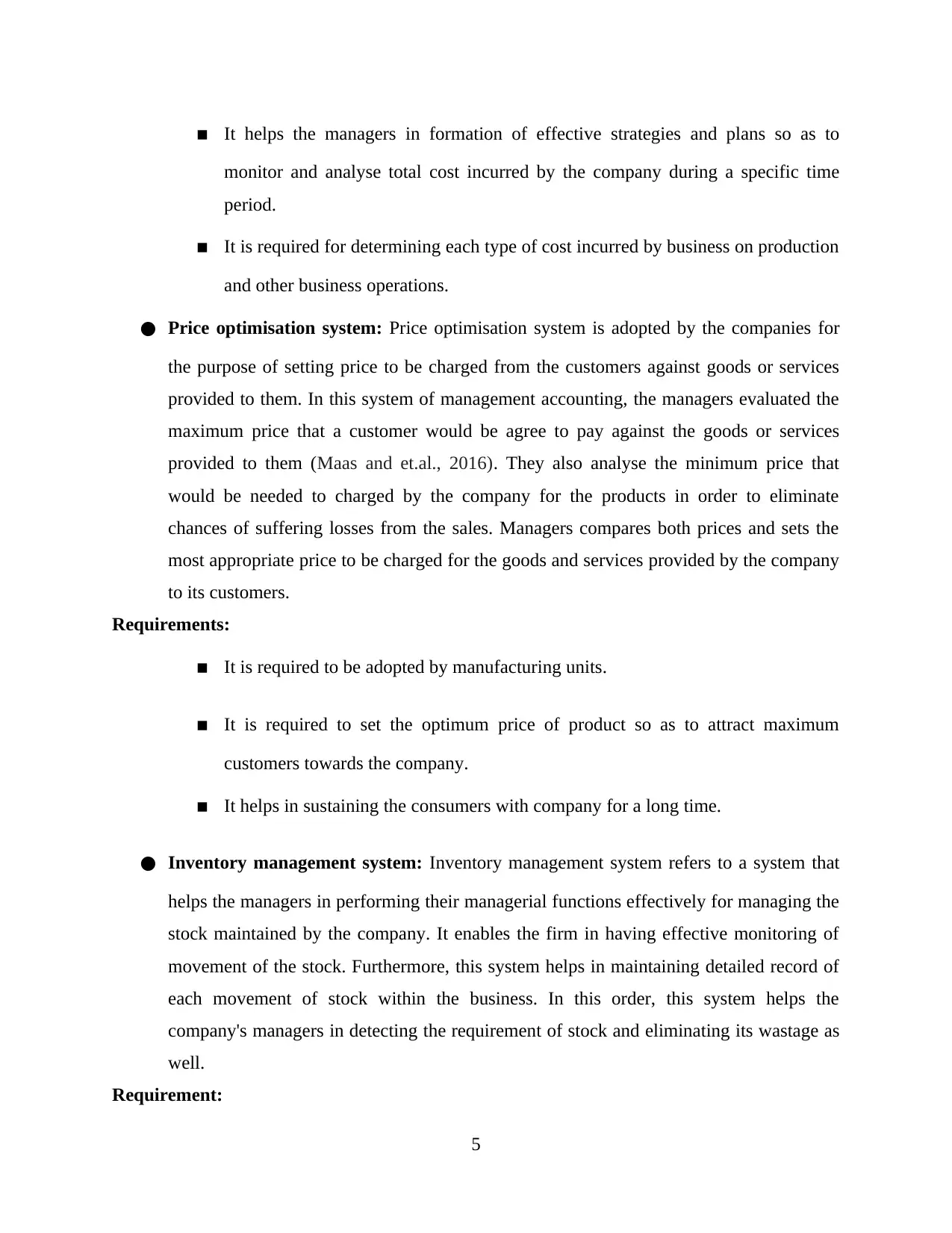
▪ It helps the managers in formation of effective strategies and plans so as to
monitor and analyse total cost incurred by the company during a specific time
period.
▪ It is required for determining each type of cost incurred by business on production
and other business operations.
● Price optimisation system: Price optimisation system is adopted by the companies for
the purpose of setting price to be charged from the customers against goods or services
provided to them. In this system of management accounting, the managers evaluated the
maximum price that a customer would be agree to pay against the goods or services
provided to them (Maas and et.al., 2016). They also analyse the minimum price that
would be needed to charged by the company for the products in order to eliminate
chances of suffering losses from the sales. Managers compares both prices and sets the
most appropriate price to be charged for the goods and services provided by the company
to its customers.
Requirements:
▪ It is required to be adopted by manufacturing units.
▪ It is required to set the optimum price of product so as to attract maximum
customers towards the company.
▪ It helps in sustaining the consumers with company for a long time.
● Inventory management system: Inventory management system refers to a system that
helps the managers in performing their managerial functions effectively for managing the
stock maintained by the company. It enables the firm in having effective monitoring of
movement of the stock. Furthermore, this system helps in maintaining detailed record of
each movement of stock within the business. In this order, this system helps the
company's managers in detecting the requirement of stock and eliminating its wastage as
well.
Requirement:
5
monitor and analyse total cost incurred by the company during a specific time
period.
▪ It is required for determining each type of cost incurred by business on production
and other business operations.
● Price optimisation system: Price optimisation system is adopted by the companies for
the purpose of setting price to be charged from the customers against goods or services
provided to them. In this system of management accounting, the managers evaluated the
maximum price that a customer would be agree to pay against the goods or services
provided to them (Maas and et.al., 2016). They also analyse the minimum price that
would be needed to charged by the company for the products in order to eliminate
chances of suffering losses from the sales. Managers compares both prices and sets the
most appropriate price to be charged for the goods and services provided by the company
to its customers.
Requirements:
▪ It is required to be adopted by manufacturing units.
▪ It is required to set the optimum price of product so as to attract maximum
customers towards the company.
▪ It helps in sustaining the consumers with company for a long time.
● Inventory management system: Inventory management system refers to a system that
helps the managers in performing their managerial functions effectively for managing the
stock maintained by the company. It enables the firm in having effective monitoring of
movement of the stock. Furthermore, this system helps in maintaining detailed record of
each movement of stock within the business. In this order, this system helps the
company's managers in detecting the requirement of stock and eliminating its wastage as
well.
Requirement:
5
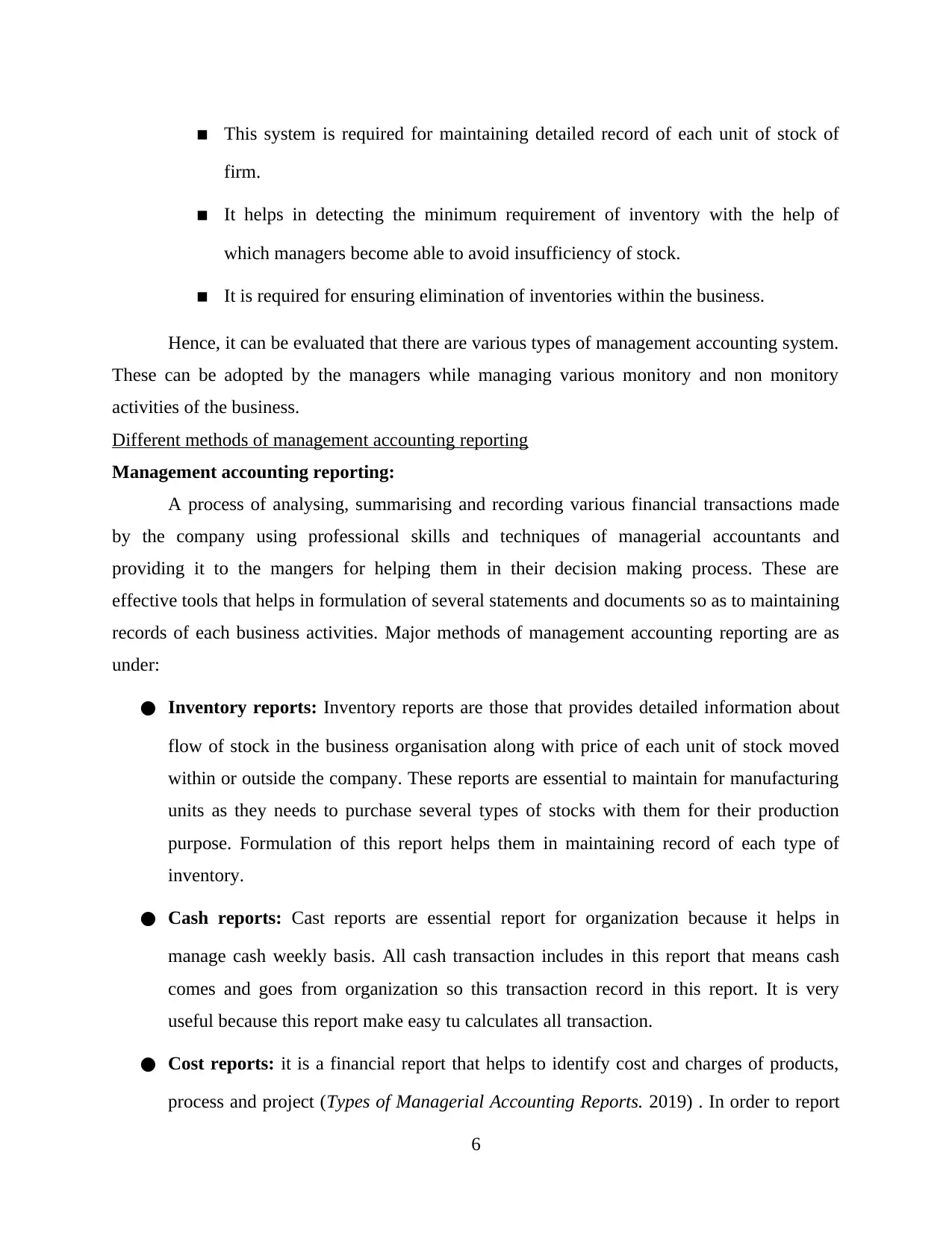
▪ This system is required for maintaining detailed record of each unit of stock of
firm.
▪ It helps in detecting the minimum requirement of inventory with the help of
which managers become able to avoid insufficiency of stock.
▪ It is required for ensuring elimination of inventories within the business.
Hence, it can be evaluated that there are various types of management accounting system.
These can be adopted by the managers while managing various monitory and non monitory
activities of the business.
Different methods of management accounting reporting
Management accounting reporting:
A process of analysing, summarising and recording various financial transactions made
by the company using professional skills and techniques of managerial accountants and
providing it to the mangers for helping them in their decision making process. These are
effective tools that helps in formulation of several statements and documents so as to maintaining
records of each business activities. Major methods of management accounting reporting are as
under:
● Inventory reports: Inventory reports are those that provides detailed information about
flow of stock in the business organisation along with price of each unit of stock moved
within or outside the company. These reports are essential to maintain for manufacturing
units as they needs to purchase several types of stocks with them for their production
purpose. Formulation of this report helps them in maintaining record of each type of
inventory.
● Cash reports: Cast reports are essential report for organization because it helps in
manage cash weekly basis. All cash transaction includes in this report that means cash
comes and goes from organization so this transaction record in this report. It is very
useful because this report make easy tu calculates all transaction.
● Cost reports: it is a financial report that helps to identify cost and charges of products,
process and project (Types of Managerial Accounting Reports. 2019) . In order to report
6
firm.
▪ It helps in detecting the minimum requirement of inventory with the help of
which managers become able to avoid insufficiency of stock.
▪ It is required for ensuring elimination of inventories within the business.
Hence, it can be evaluated that there are various types of management accounting system.
These can be adopted by the managers while managing various monitory and non monitory
activities of the business.
Different methods of management accounting reporting
Management accounting reporting:
A process of analysing, summarising and recording various financial transactions made
by the company using professional skills and techniques of managerial accountants and
providing it to the mangers for helping them in their decision making process. These are
effective tools that helps in formulation of several statements and documents so as to maintaining
records of each business activities. Major methods of management accounting reporting are as
under:
● Inventory reports: Inventory reports are those that provides detailed information about
flow of stock in the business organisation along with price of each unit of stock moved
within or outside the company. These reports are essential to maintain for manufacturing
units as they needs to purchase several types of stocks with them for their production
purpose. Formulation of this report helps them in maintaining record of each type of
inventory.
● Cash reports: Cast reports are essential report for organization because it helps in
manage cash weekly basis. All cash transaction includes in this report that means cash
comes and goes from organization so this transaction record in this report. It is very
useful because this report make easy tu calculates all transaction.
● Cost reports: it is a financial report that helps to identify cost and charges of products,
process and project (Types of Managerial Accounting Reports. 2019) . In order to report
6
⊘ This is a preview!⊘
Do you want full access?
Subscribe today to unlock all pages.

Trusted by 1+ million students worldwide
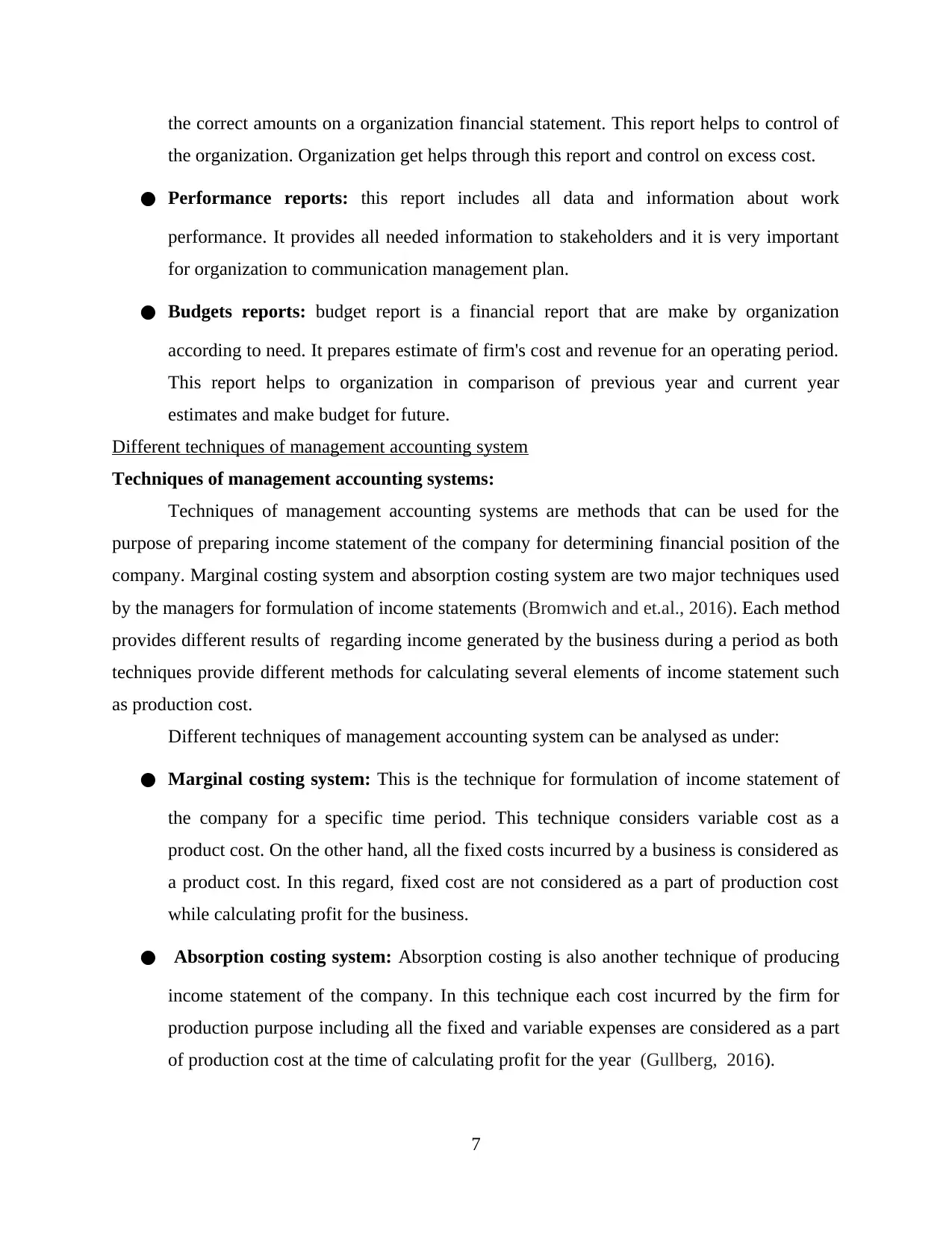
the correct amounts on a organization financial statement. This report helps to control of
the organization. Organization get helps through this report and control on excess cost.
● Performance reports: this report includes all data and information about work
performance. It provides all needed information to stakeholders and it is very important
for organization to communication management plan.
● Budgets reports: budget report is a financial report that are make by organization
according to need. It prepares estimate of firm's cost and revenue for an operating period.
This report helps to organization in comparison of previous year and current year
estimates and make budget for future.
Different techniques of management accounting system
Techniques of management accounting systems:
Techniques of management accounting systems are methods that can be used for the
purpose of preparing income statement of the company for determining financial position of the
company. Marginal costing system and absorption costing system are two major techniques used
by the managers for formulation of income statements (Bromwich and et.al., 2016). Each method
provides different results of regarding income generated by the business during a period as both
techniques provide different methods for calculating several elements of income statement such
as production cost.
Different techniques of management accounting system can be analysed as under:
● Marginal costing system: This is the technique for formulation of income statement of
the company for a specific time period. This technique considers variable cost as a
product cost. On the other hand, all the fixed costs incurred by a business is considered as
a product cost. In this regard, fixed cost are not considered as a part of production cost
while calculating profit for the business.
● Absorption costing system: Absorption costing is also another technique of producing
income statement of the company. In this technique each cost incurred by the firm for
production purpose including all the fixed and variable expenses are considered as a part
of production cost at the time of calculating profit for the year (Gullberg, 2016).
7
the organization. Organization get helps through this report and control on excess cost.
● Performance reports: this report includes all data and information about work
performance. It provides all needed information to stakeholders and it is very important
for organization to communication management plan.
● Budgets reports: budget report is a financial report that are make by organization
according to need. It prepares estimate of firm's cost and revenue for an operating period.
This report helps to organization in comparison of previous year and current year
estimates and make budget for future.
Different techniques of management accounting system
Techniques of management accounting systems:
Techniques of management accounting systems are methods that can be used for the
purpose of preparing income statement of the company for determining financial position of the
company. Marginal costing system and absorption costing system are two major techniques used
by the managers for formulation of income statements (Bromwich and et.al., 2016). Each method
provides different results of regarding income generated by the business during a period as both
techniques provide different methods for calculating several elements of income statement such
as production cost.
Different techniques of management accounting system can be analysed as under:
● Marginal costing system: This is the technique for formulation of income statement of
the company for a specific time period. This technique considers variable cost as a
product cost. On the other hand, all the fixed costs incurred by a business is considered as
a product cost. In this regard, fixed cost are not considered as a part of production cost
while calculating profit for the business.
● Absorption costing system: Absorption costing is also another technique of producing
income statement of the company. In this technique each cost incurred by the firm for
production purpose including all the fixed and variable expenses are considered as a part
of production cost at the time of calculating profit for the year (Gullberg, 2016).
7
Paraphrase This Document
Need a fresh take? Get an instant paraphrase of this document with our AI Paraphraser
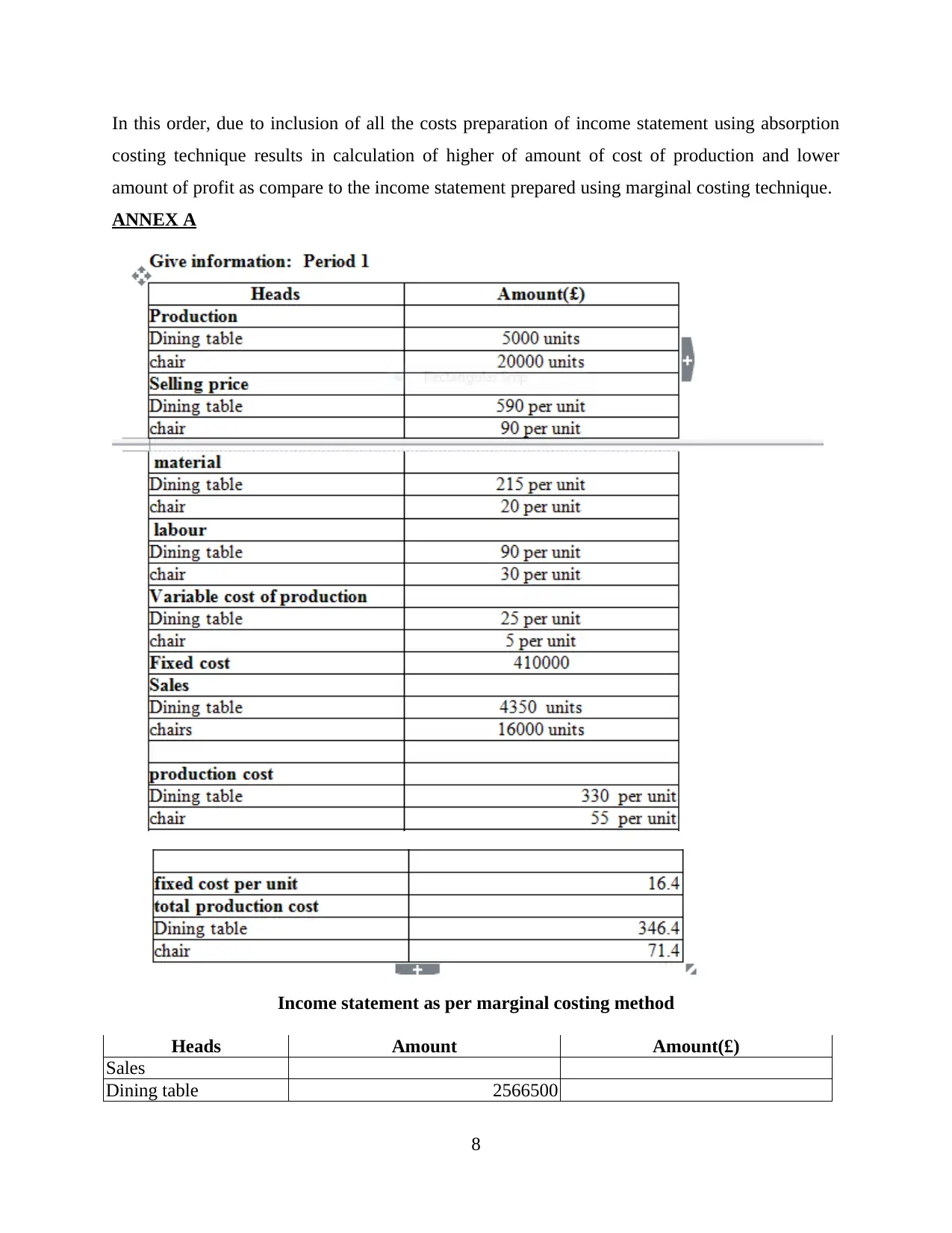
In this order, due to inclusion of all the costs preparation of income statement using absorption
costing technique results in calculation of higher of amount of cost of production and lower
amount of profit as compare to the income statement prepared using marginal costing technique.
ANNEX A
Income statement as per marginal costing method
Heads Amount Amount(£)
Sales
Dining table 2566500
8
costing technique results in calculation of higher of amount of cost of production and lower
amount of profit as compare to the income statement prepared using marginal costing technique.
ANNEX A
Income statement as per marginal costing method
Heads Amount Amount(£)
Sales
Dining table 2566500
8
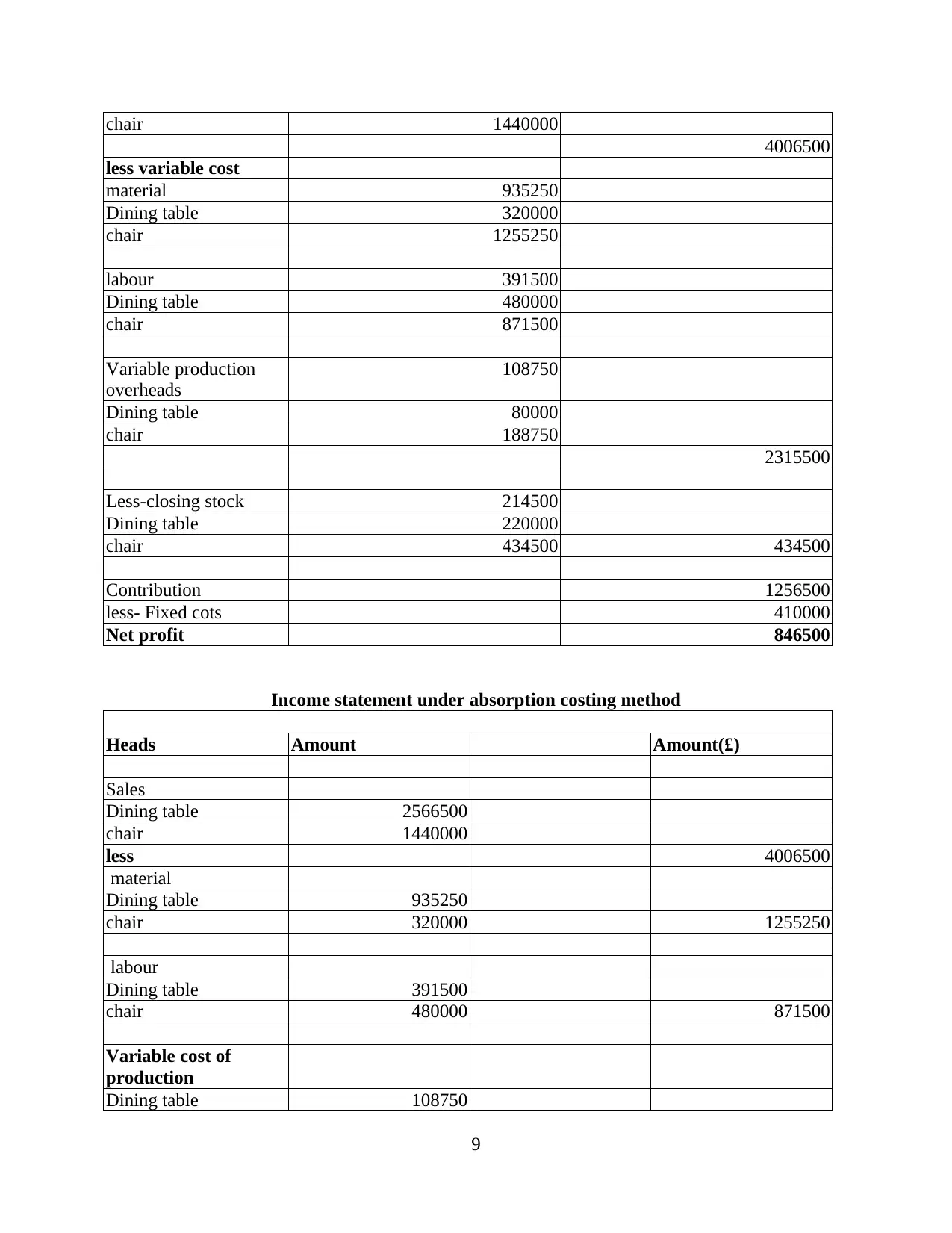
chair 1440000
4006500
less variable cost
material 935250
Dining table 320000
chair 1255250
labour 391500
Dining table 480000
chair 871500
Variable production
overheads
108750
Dining table 80000
chair 188750
2315500
Less-closing stock 214500
Dining table 220000
chair 434500 434500
Contribution 1256500
less- Fixed cots 410000
Net profit 846500
Income statement under absorption costing method
Heads Amount Amount(£)
Sales
Dining table 2566500
chair 1440000
less 4006500
material
Dining table 935250
chair 320000 1255250
labour
Dining table 391500
chair 480000 871500
Variable cost of
production
Dining table 108750
9
4006500
less variable cost
material 935250
Dining table 320000
chair 1255250
labour 391500
Dining table 480000
chair 871500
Variable production
overheads
108750
Dining table 80000
chair 188750
2315500
Less-closing stock 214500
Dining table 220000
chair 434500 434500
Contribution 1256500
less- Fixed cots 410000
Net profit 846500
Income statement under absorption costing method
Heads Amount Amount(£)
Sales
Dining table 2566500
chair 1440000
less 4006500
material
Dining table 935250
chair 320000 1255250
labour
Dining table 391500
chair 480000 871500
Variable cost of
production
Dining table 108750
9
⊘ This is a preview!⊘
Do you want full access?
Subscribe today to unlock all pages.

Trusted by 1+ million students worldwide
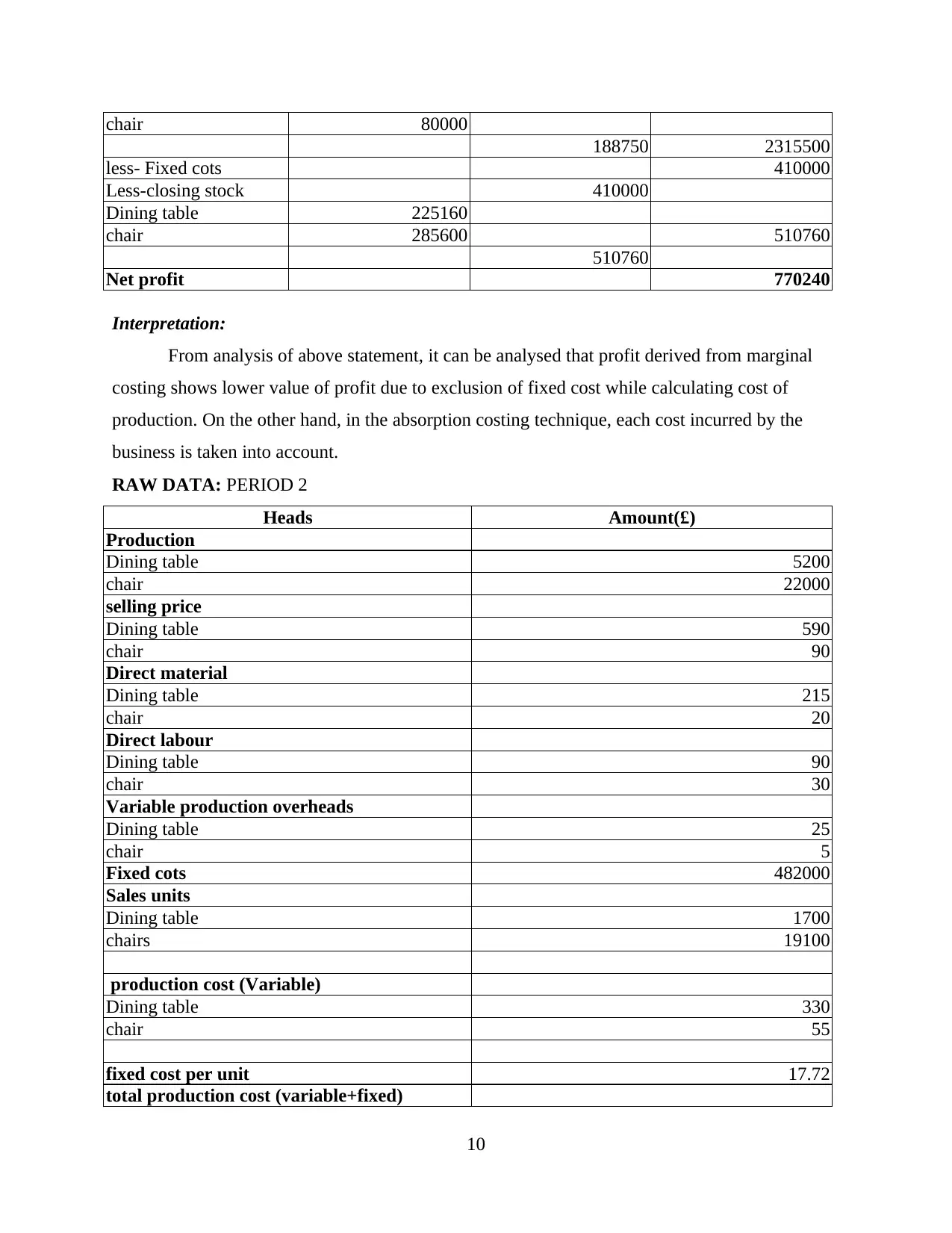
chair 80000
188750 2315500
less- Fixed cots 410000
Less-closing stock 410000
Dining table 225160
chair 285600 510760
510760
Net profit 770240
Interpretation:
From analysis of above statement, it can be analysed that profit derived from marginal
costing shows lower value of profit due to exclusion of fixed cost while calculating cost of
production. On the other hand, in the absorption costing technique, each cost incurred by the
business is taken into account.
RAW DATA: PERIOD 2
Heads Amount(£)
Production
Dining table 5200
chair 22000
selling price
Dining table 590
chair 90
Direct material
Dining table 215
chair 20
Direct labour
Dining table 90
chair 30
Variable production overheads
Dining table 25
chair 5
Fixed cots 482000
Sales units
Dining table 1700
chairs 19100
production cost (Variable)
Dining table 330
chair 55
fixed cost per unit 17.72
total production cost (variable+fixed)
10
188750 2315500
less- Fixed cots 410000
Less-closing stock 410000
Dining table 225160
chair 285600 510760
510760
Net profit 770240
Interpretation:
From analysis of above statement, it can be analysed that profit derived from marginal
costing shows lower value of profit due to exclusion of fixed cost while calculating cost of
production. On the other hand, in the absorption costing technique, each cost incurred by the
business is taken into account.
RAW DATA: PERIOD 2
Heads Amount(£)
Production
Dining table 5200
chair 22000
selling price
Dining table 590
chair 90
Direct material
Dining table 215
chair 20
Direct labour
Dining table 90
chair 30
Variable production overheads
Dining table 25
chair 5
Fixed cots 482000
Sales units
Dining table 1700
chairs 19100
production cost (Variable)
Dining table 330
chair 55
fixed cost per unit 17.72
total production cost (variable+fixed)
10
Paraphrase This Document
Need a fresh take? Get an instant paraphrase of this document with our AI Paraphraser
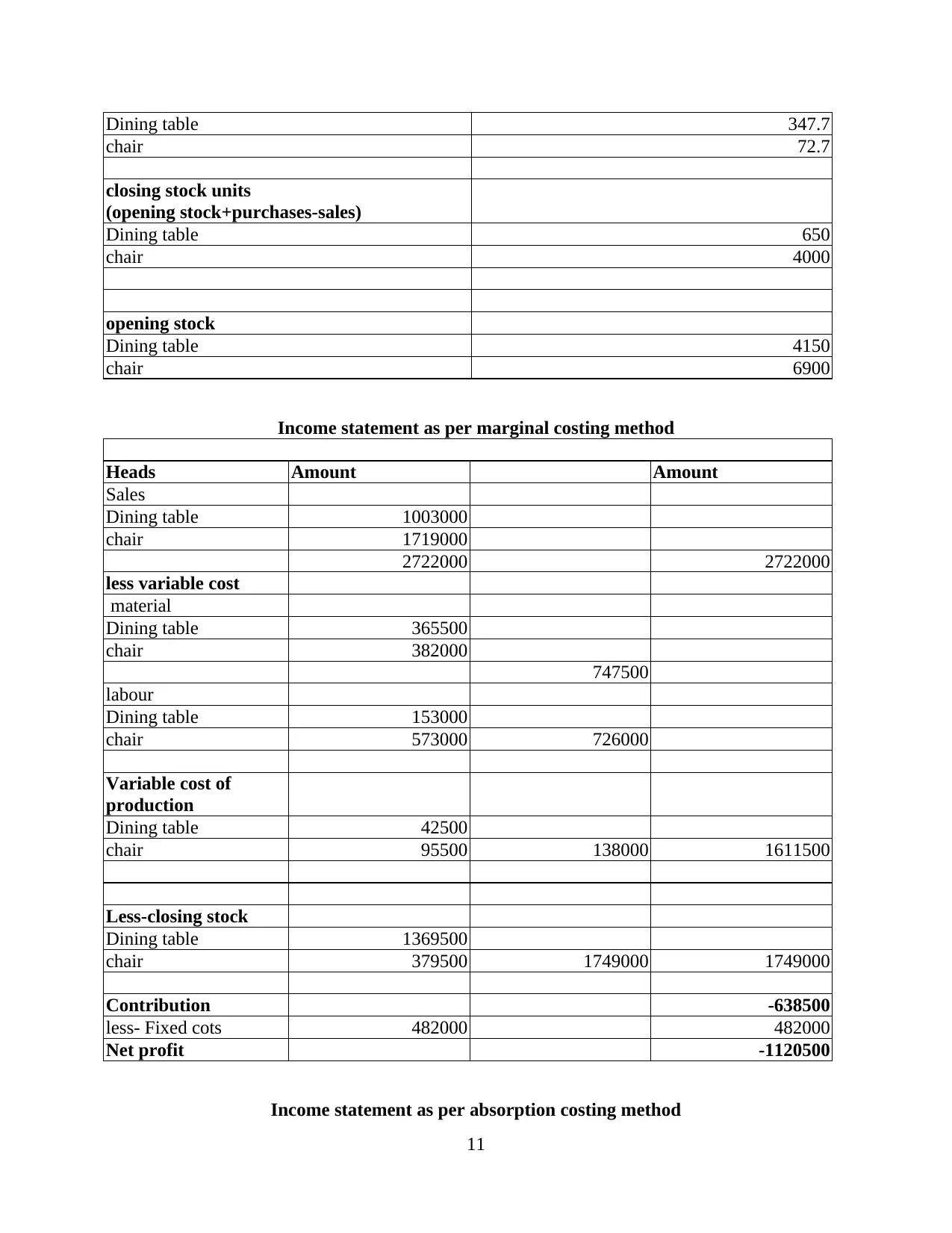
Dining table 347.7
chair 72.7
closing stock units
(opening stock+purchases-sales)
Dining table 650
chair 4000
opening stock
Dining table 4150
chair 6900
Income statement as per marginal costing method
Heads Amount Amount
Sales
Dining table 1003000
chair 1719000
2722000 2722000
less variable cost
material
Dining table 365500
chair 382000
747500
labour
Dining table 153000
chair 573000 726000
Variable cost of
production
Dining table 42500
chair 95500 138000 1611500
Less-closing stock
Dining table 1369500
chair 379500 1749000 1749000
Contribution -638500
less- Fixed cots 482000 482000
Net profit -1120500
Income statement as per absorption costing method
11
chair 72.7
closing stock units
(opening stock+purchases-sales)
Dining table 650
chair 4000
opening stock
Dining table 4150
chair 6900
Income statement as per marginal costing method
Heads Amount Amount
Sales
Dining table 1003000
chair 1719000
2722000 2722000
less variable cost
material
Dining table 365500
chair 382000
747500
labour
Dining table 153000
chair 573000 726000
Variable cost of
production
Dining table 42500
chair 95500 138000 1611500
Less-closing stock
Dining table 1369500
chair 379500 1749000 1749000
Contribution -638500
less- Fixed cots 482000 482000
Net profit -1120500
Income statement as per absorption costing method
11
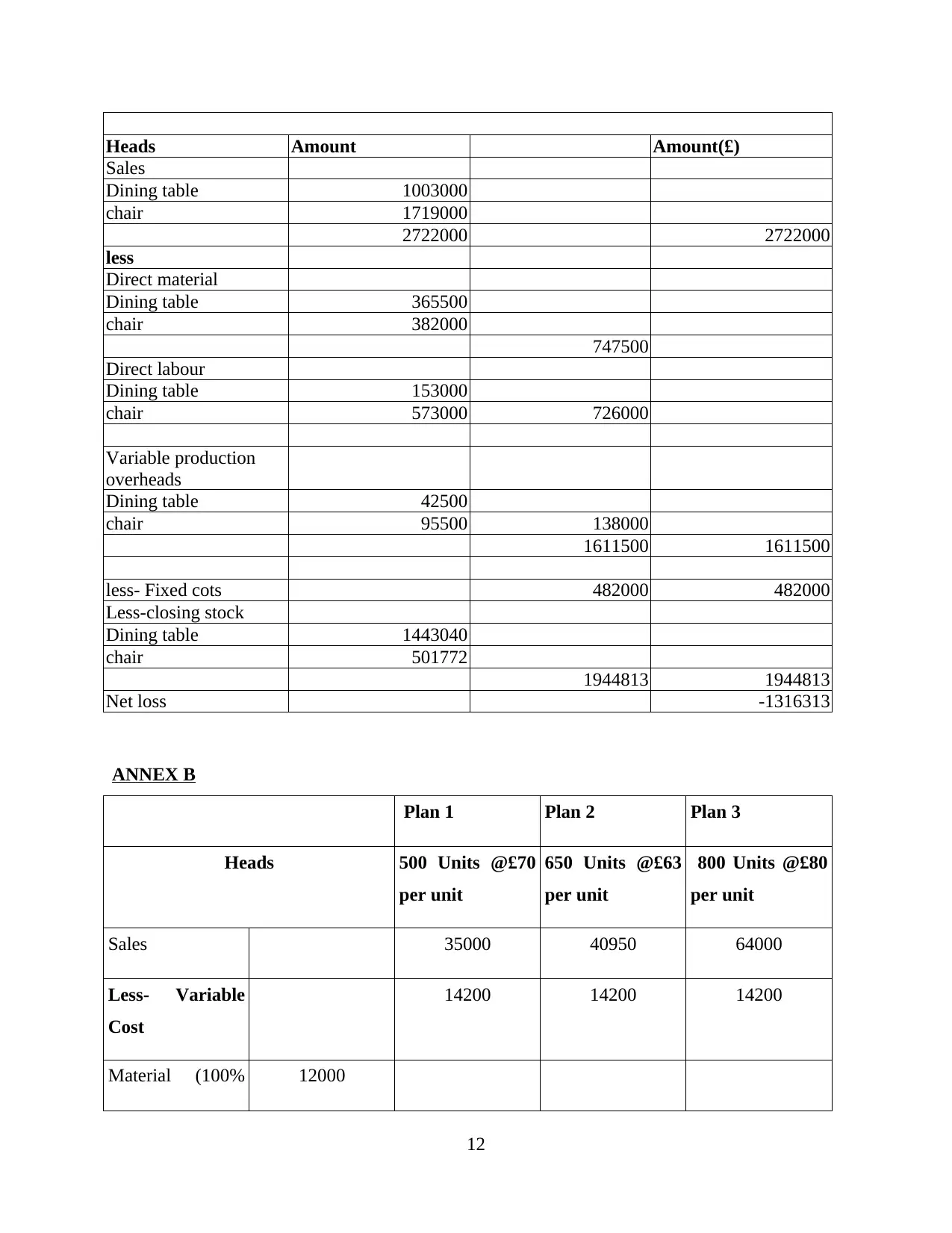
Heads Amount Amount(£)
Sales
Dining table 1003000
chair 1719000
2722000 2722000
less
Direct material
Dining table 365500
chair 382000
747500
Direct labour
Dining table 153000
chair 573000 726000
Variable production
overheads
Dining table 42500
chair 95500 138000
1611500 1611500
less- Fixed cots 482000 482000
Less-closing stock
Dining table 1443040
chair 501772
1944813 1944813
Net loss -1316313
ANNEX B
Plan 1 Plan 2 Plan 3
Heads 500 Units @£70
per unit
650 Units @£63
per unit
800 Units @£80
per unit
Sales 35000 40950 64000
Less- Variable
Cost
14200 14200 14200
Material (100% 12000
12
Sales
Dining table 1003000
chair 1719000
2722000 2722000
less
Direct material
Dining table 365500
chair 382000
747500
Direct labour
Dining table 153000
chair 573000 726000
Variable production
overheads
Dining table 42500
chair 95500 138000
1611500 1611500
less- Fixed cots 482000 482000
Less-closing stock
Dining table 1443040
chair 501772
1944813 1944813
Net loss -1316313
ANNEX B
Plan 1 Plan 2 Plan 3
Heads 500 Units @£70
per unit
650 Units @£63
per unit
800 Units @£80
per unit
Sales 35000 40950 64000
Less- Variable
Cost
14200 14200 14200
Material (100% 12000
12
⊘ This is a preview!⊘
Do you want full access?
Subscribe today to unlock all pages.

Trusted by 1+ million students worldwide
1 out of 19
Related Documents
Your All-in-One AI-Powered Toolkit for Academic Success.
+13062052269
info@desklib.com
Available 24*7 on WhatsApp / Email
![[object Object]](/_next/static/media/star-bottom.7253800d.svg)
Unlock your academic potential
Copyright © 2020–2025 A2Z Services. All Rights Reserved. Developed and managed by ZUCOL.





